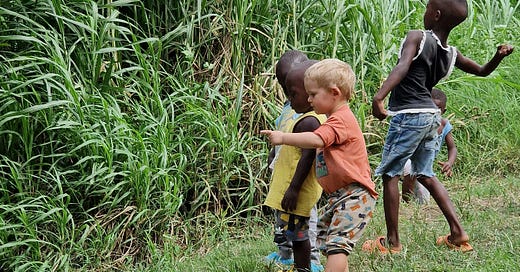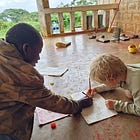Why are kids all busting their ACLs?
Cruciate ruptures are up 2000% in UK children since 2000. Why?
When did you learn how to fall?
The shadows are lengthening, the air is heavy with the delicate scent of the wild Amaryllis flowers, and the concrete wall of the community kitchen feels pleasantly cool despite the hot, humid air.
The score is one-all, the final whistle approaching, and the players are focused. Not for them the shrieks and curses - people in this village don’t show strong emotions. I watch children, adolescents, and adults playing together. There isn’t a shoe in sight. Despite the tussocks of turf, falls are common.
Play is fast and furious. A young teenager, racing past with the ball, is tackled. Off-balance, he spins out of control, twisting and reaching before he hits the ground. Somehow, I don’t see how, he gets his shoulder down. The momentum carries him over and he rolls it out, ending up on his knees. He grins ruefully. He reaches for an offered hand, stands, shakes himself, and re-enters the game.
ACL injuries are increasingly common
Anterior cruciate ligament injuries used to be very uncommon in children. They were the footballers’ injuries - seen in elite sportspeople or unlucky paratroopers.
Not any more. Kids are busting their ACLs over twenty times more frequently than in the year 2000. This isn’t a genetic problem - genetic problems don’t suddenly occur to this extent in a couple of decades. Nope, something is going wrong with how we’re raising our children and this has consequences for both their short- and long-term health.
But how much of a problem are ACL injuries really?. Many football-mad kids will have seen their sporting heroes incapacitated by and recovering from this injury. It’s the injury that shows that you play sport and you’re not afraid of a gnarly tackle. It’s almost cool.
The truth is less glamorous. ACL injuries are life changing. Children who injure their ACLs are ten times more likely to develop early-onset arthritis compared to those who don’t. That means creaking around instead of running around when you’re trying to play football with your own football-obsessed kids. (Just in case you’re wondering, my ACL is currently doing just fine. That clearly has nothing to do with the fact that I was a sedentary, overweight kid who could only dream about being picked for a football team. I’m not bitter at all).
A child’s movement patterns can protect their bodies from injury
So what’s going wrong? Let’s start with the headline news. Today’s kids are the most sedentary generation that human history has ever seen. They have grown up replacing outdoor play with indoor play, walking with scooting, sticks with Wii controllers, and park time with screen time. And the consequences are becoming increasingly clear. From the primary school teacher who sees children who can’t support themselves sitting on the floor for a short assembly, to the sky-rocketing rates of mental health disorders in children - we can’t completely alter how a small mammal grows and develops and not expect to see problems arising.
How does this link to ACL injuries? Well, there are certain things that a person can do that significantly increase the likelihood of injuries. Twisting awkwardly. Landing badly. Running with an abnormal gait. But these injuries don’t happen randomly. Children who know how their body moves, who have good ‘movement competence’, are much better able to deal with those unexpected situations. They are able to shift their body to keep it moving in the planes that it can deal with. They set themselves up to land well before they move in the first place. And they have developed an efficient gait from lots of time moving around unhampered by big nappies, by heavy stiff shoes, and by sitting in chairs. Oops, I’m getting carried away. If you’re interested in following this rant further, there’s more in my book, “Growing up WEIRD”.
To move well when older, children need to move a lot when young
Anyway, movement competence. Children who are movement competent have good fundamental movement skills:
running,
jumping,
hopping,
skipping,
throwing,
catching.
The UK Physical Education curriculum suggests that these skills should be mastered by seven-year-olds, but in the UK, that doesn’t happen until towards the end of primary school or even later.
A recent study looked at the fundamental movement skills in a group of ten- to thirteen-year-olds who played grassroots football. It assessed their fundamental movement skills and then looked at their risk of ACL injury by looking at the errors they made when they were performing a high-risk movement that is associated with ACL injury. Children with worse fundamental movement skills were much more likely to land badly.
So how do children develop their fundamental movement skills? They do this by spending a lot of time outside playing in environments that stimulate these movements. And these skills themselves are built on even simpler skills.
Children need to
do a lot of walking (and don’t worry, I’ll give some inspiration here in a later article. For now, try parking further away from school, and look for shops or places of interest close to your house that can be places to visit)
spend their sitting time on the floor rather than on chairs (children sitting on the floor move more frequently, engage their core more, and use their arms and shoulders when standing up and sitting down). How could you make sitting on the floor more appealing?
Hang and swing frequently from their arms. I have so many ideas for this! Parks are obvious - but how about ropes or rings hung from a pull up bar in your house? Got a strong shelf? What can you hang off it? When there are things to hang on, children hang on things!
These develop the big gross motor skills upon which they build the more sophisticated fundamental movement skills.
Sports are much safer when you know how to move
Sports practice does not provide fundamental movement training. Almost all of the sports that we do in the UK involve a lot of non-physiological movements (i.e. not the movements that your great-, great-, great-, great-grandparents would have made). They are great fun, a much-needed opportunity to run around and get one’s heart rate up, and provide goal-setting and focus for our lives. But movement-wise, they are often quite limited and quite unphysiological. That’s why injury rates are high for a lot of sports and why the big paediatric associations advise against children specialising in any particular sport. Humans are meant to do loads of different movements all day, every day, and it’s even more important when we’re growing.
So, what do we do? Children need to spend most of their time outside in unstructured play, with friends, in places that they can hang, swing, and climb. They need to walk lots every day (do you have a local shop or post box? Can you use a local delivery drop box rather than getting everything to your door?Can you park a mile away from school and give the children some movement down time between school and home). And if you’re a bookworm, read Katy Bowman’s book ‘Grow Wild’ or listen to her Nutritious Movement podcast for more ways to get children to move
To get the benefits of sports with a lower risk of injury, go into those sports with a solid foundation of fundamental movement skills. These will make our bodies better able to do those abnormal movements without getting injured, and they will also improve our sporting performance. As someone who has terrible fundamental movement skills, I fully appreciate how difficult it is to catch a ball when you’re not even sure where your arm is in space.
You may also like:
Prefer a podcast?
Read more:
Duncan, Michael J., et al. "Run, jump, throw and catch: How proficient are children attending English schools at the fundamental motor skills identified as key within the school curriculum?." European Physical Education Review 26.4 (2020): 814-826.
Duncan, Michael J., et al. "The Relationship Between Motor Competence and Landing Error Scoring System Performance in Youth Soccer Players." The Journal of Strength & Conditioning Research 38.9 (2024): e496-e502.










It seems like a major factor is that labour in our societies have shifted from manual to cognitive, and the price has been our physiology. 'Physical education', which I contend is largely not educational as much as recreational, has almost completely disappeared from schools as a mandatory element of learning; students who skip PE are likely not to face any consequences. I understand this, because PE is largely aimed at group sports, rather than explaining and exploring movement in a more systematic and intelligent way. I would probably skip PE as well, taught as it is today, and I love physical activity.
In education, lip-service is given to the role of the physical in intellectual and emotional processing, but it is clearly not applied; teachers are just as guilty as students of living sedentary lives. The truth is, there is no mind-body divide; no 'axis', no point of separation or connection, it's all the same thing. Move well, think well, live well.